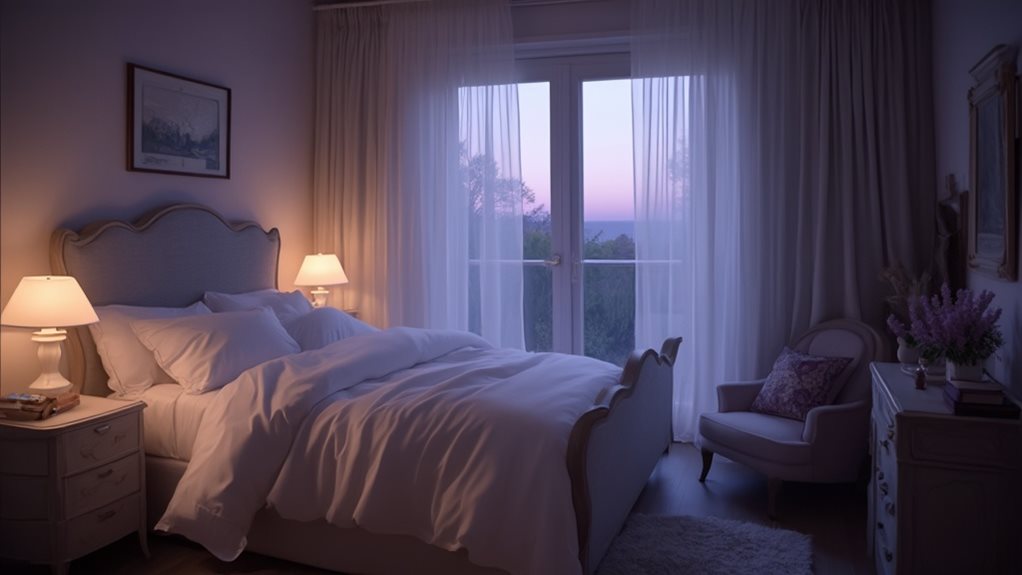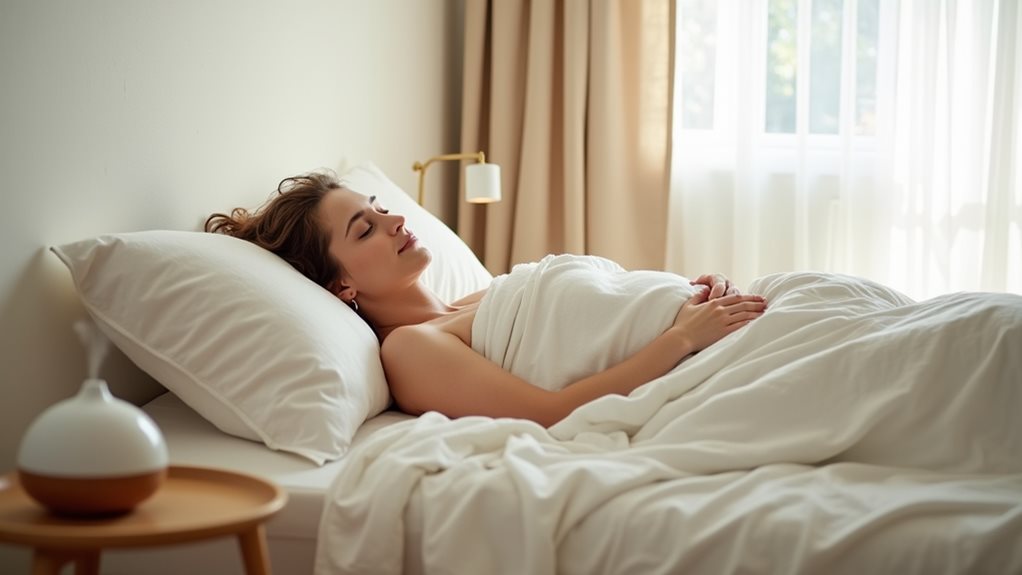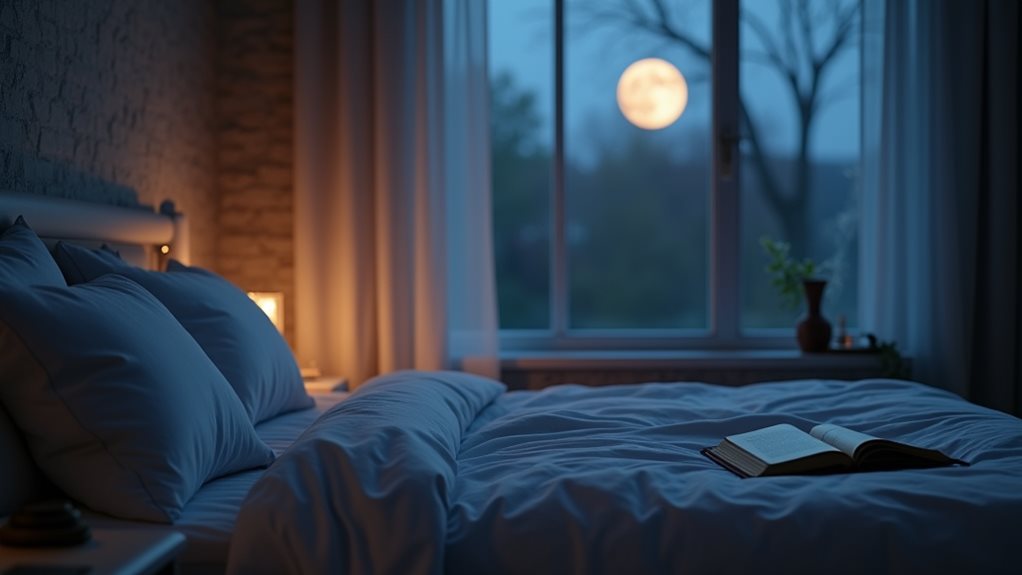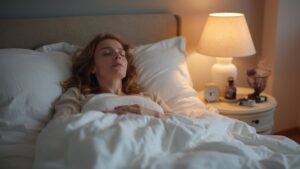
Hypnosis scripts specifically designed for sleep focus on delivering deep relaxation techniques, utilizing visualization strategies, and addressing subconscious sleep disruptions. They effectively reprogram the mind for a peaceful passage into sleep by identifying and neutralizing triggers that hinder restful slumber. These scripts combine cognitive behavioral approaches with hypnotic suggestions to enhance sleep hygiene and provide a holistic solution. Implementing these practices regularly can lead to significant improvements in sleep quality and overall mental health. Exploring further can offer additional insights and practical tips.
Key Takeaways
- Hypnosis scripts guide deep relaxation, reprogramming the mind for a peaceful sleep transition.
- Combining visualization with hypnotic scripts promotes a calming mental environment conducive to sleep.
- Scripts often incorporate deep muscle relaxation techniques to alleviate physical tension and ease into sleep.
- Regular use of sleep hypnosis scripts can enhance overall sleep quality by addressing stress and anxiety.
- Integrating sleep hygiene practices with hypnosis scripts maximizes effectiveness, improving sleep consistency.
Benefits of Hypnosis for Enhanced Sleep Quality
Hypnosis offers a powerful tool for enhancing sleep quality by tapping into the deep-seated connection between mind and body.
By identifying specific sleep triggers and employing targeted relaxation techniques, hypnosis guides individuals towards a state of deep relaxation essential for restorative sleep.
These methods skillfully quiet the mind and relax the body, addressing stress and anxiety which often disrupt sleep.
Through the strategic use of soothing verbal cues and calming narratives, hypnosis effectively reprograms the subconscious, fostering a peaceful passage into sleep.
This approach not only improves sleep quality but also enhances overall well-being, making it a valuable practice for those seeking rejuvenation.
Creating the Perfect Environment for Sleep Hypnosis
While enhancing sleep quality through hypnosis is effective, the physical environment where one practices these techniques greatly impacts their success.
Creating a conducive setting involves multiple sensory adjustments to foster relaxation and receptivity to hypnosis:
- Ambient Lighting: Utilize soft, dim lighting to signal the brain that it's time to unwind.
- Calming Scents: Introduce aromas like lavender or chamomile to enhance the calming atmosphere.
- Quiet Space: Guarantee the area is free from disruptive noises that could distract from the focus needed during hypnosis.
- Comfortable Furnishings: Use supportive yet cozy seating or bedding to promote physical ease.
Mastering Deep Muscle Relaxation Techniques

Mastering deep muscle relaxation techniques begins by understanding their fundamental role in promoting restful sleep.
These methods focus on enhancing muscle awareness, teaching individuals to identify and release tension systematically. By following relaxation cues, one can progressively relax each muscle group, starting from the toes and moving towards the head.
This practice not only alleviates physical stress but also calms the mind, preparing it for sleep.
Scientifically, this approach activates the parasympathetic nervous system, reducing heart rate and blood pressure, which are critical for entering a state of deep sleep.
Regular practice solidifies these skills, leading to improved sleep quality.
Visualization Strategies for Peaceful Sleep
Visualization strategies harness the power of the mind's imagery to induce a state of tranquility essential for peaceful sleep.
By picturing serene environments or scenarios, individuals can shift their mind towards a sleep-ready state, facilitated by the integration of dream imagery and calming affirmations.
Here are key steps:
- Select Peaceful Scenarios: Imagine tranquil settings such as a quiet beach at sunset.
- Incorporate Dream Imagery: Envision interactions with soothing elements like gentle waves.
- Use Calming Affirmations: Repeat phrases like "I am at peace" to reinforce a state of relaxation.
- Focus on Detail: Engage senses by visualizing textures, sounds, and scents.
Overcoming Insomnia Through Hypnosis and Sleep Hygiene Practices

Addressing insomnia through the combined use of hypnosis and sleep hygiene practices offers a structured pathway to improved sleep.
This method integrates cognitive therapy techniques, fostering a reprogramming of the mind's perception of sleep. Sleep hygiene, including consistent sleep-wake schedules and an ideal sleep environment, complements the hypnotic suggestions by reinforcing daily habits that promote restfulness.
As cognitive therapy addresses psychological barriers like anxiety, hypnosis gently guides the subconscious towards a more peaceful sleep state.
Together, these practices not only enhance sleep quality but also contribute to overall mental health, laying a foundation for sustained sleep improvement.
Frequently Asked Questions
How Long Does a Typical Sleep Hypnosis Session Last?
A typical sleep hypnosis session duration may vary, generally lasting from 30 to 60 minutes. These sessions utilize specific hypnosis techniques designed to induce relaxation and promote a deep, restorative state of sleep.
Can Sleep Hypnosis Help With Sleepwalking or Nightmares?
Amid uncertainties, sleep hypnosis potentially addresses sleepwalking triggers and nightmare resolution. Scientifically, it may offer therapeutic avenues, modifying subconscious patterns and fostering a calmer sleep state through targeted, practical script applications.
Are There Any Age Restrictions for Using Sleep Hypnosis?
The question concerns age suitability for sleep hypnosis. Hypnosis guidelines suggest it is generally safe for most ages, but specific adaptations may be required for children and the elderly to guarantee safety and effectiveness.
How Often Should I Practice Hypnosis to See Improvements in Sleep?
To improve sleep, experts whimsically suggest hypnosis could be as routine as brushing teeth. Frequency guidelines recommend nightly sessions initially, gradually adjusting as sleep enhancement is observed, merging science with practical bedtime rituals.
Can Sleep Hypnosis Replace Sleep Medication Prescribed by My Doctor?
Sleep hypnosis may enhance relaxation and reduce medication dependency, but it should not replace prescribed treatments without a doctor's guidance. Its effectiveness varies, and professional medical advice is essential for managing health conditions.
Conclusion
In the tapestry of night, where each thread symbolizes a potential remedy for restlessness, hypnosis scripts emerge as the golden strands. Woven into the fabric of nightly routines, these scripts act like gentle whispers, guiding the weary traveler through a landscape of tranquility and deep rest. By transforming the bedroom into a sanctuary and the mind into an ally, they offer a profound solution to the puzzle of insomnia, promising nights filled with peaceful slumber and mornings replete with renewal.





